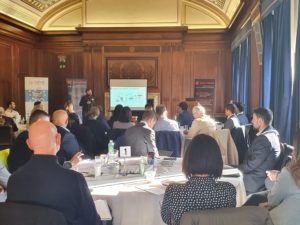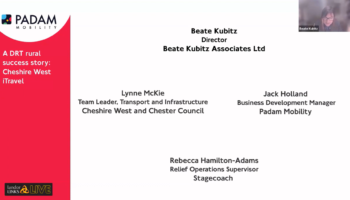With the funding announcement for BSIPs due in the next few weeks, we look at how dynamic, demand-responsive transport services can improve local transport for people, especially in rural and peri-urban areas.
Recently Jack Holland set out key insights and practical tips on how to succeed in implementing a dynamic on-demand system at a Transport Smart Class in Nottingham.

Tip 1. Use Data to undertake a deep analysis and test your service
Padam Mobility’s pre-service deployment simulations are critical tools for designing your DDRT service. We help you answer:
- When and where is demand particularly high?
- How many passengers will be transported at different times?
- What is the right service area?
These questions help develop your service model and minimize potential risk. Our partnership with Prospective Labs also helps analyze the use of existing infrastructure in greater detail, and identify gaps in the network area.
There’s more about this topic and the partnership between Prospective Labs and Padam Mobility in our webinar „Using data science to increase the success of your DRT scheme“.
Tip 2. Determine the right service configuration
There are several configurations of DDRT that can meet different needs and improve the transport network.
For example, if there are a lot of gaps in the fixed line bus network (for instance in a more rural area) a free-floating service may be the best choice to serve the demand.
Alternatively, where there are some important central locations, such as a train station, a hospital, a shopping centre, etc., it may make sense to set up a DDRT service in a ‘fixed route’ model, connecting people with key nodes based on demand.
Another potential deployment is as a feeder service that, for example, serves a zone connecting people within it to the nearest fixed route bus stop, train or tram station and thus ‘feeds’ the structural network.
Tip 3. Ensure advanced bookings are guaranteed
A key component in gaining the trust and satisfaction of customers is not only enabling bookings in advance but also ensuring they are guaranteed.
Padam Mobility’s algorithms guarantee a seat in a vehicle at the desired time by allocating a seat when the booking is made. Guaranteeing bookings in this way is a core feature that is ingrained into the foundations of the Padam Mobility system. This is different from most providers of on-demand services, who store bookings made in advance on a waiting list and thus can only provide customers with an approximate estimated time of arrival (ETA) window.
This feature is essential for a successful DRT service, as people need to know that they can rely on the service, allowing them to plan their daily schedules.
Usage data shows that advance bookings are extremely important to on-demand services. 75 % of all bookings via Padam Mobility solutions are made in advance. The remaining trip searches, for services in real-time, are only shown potential trips that have not been booked. This system fulfills all requirements equally and makes on-demand transport attractive for different types of users.
Tip 4. Offer a variety of booking methods
The choice of booking methods is key to making DDRT fully accessible to all types of users of all ages.
Users have the option of choosing between booking via mobile app, a booking website or a call centre. This flexibility eliminates the hurdle of making a booking, especially for users who cannot or do not want to use a smartphone.
Padam Mobility offers all three booking components as modules, so operators can create their own service package.
Tip 5. A clear and comprehensive marketing strategy
A marketing campaign for new DDRT services is essential, ideally starting before the launch of the service. Without (sufficient) advertising for the DDRT service, there is a high risk that not enough people will become aware of it and thus not enough users will be generated.
It’s important to integrate all the channels at the operator’s disposal. In particular, social media – including Twitter accounts and Facebook pages for the operator and any local area information service – are useful for monitoring the reception and use of the services. Targeted advertising on social media is also useful to reach different audiences with targeted messages.
Press work with local newspapers can also increase the visibility of services. It’s important to tailor information to the user groups and to convey positive messages about the benefits of the service (e.g. “DRT makes you independent from the parent taxi”) as well as providing basic information (e.g. “How does booking work?”). More generally, the entire area served should be included in the PR; besides newspaper announcements, flyers in residents’ letterboxes or billboards in central locations can also yield results.
In areas with fewer inhabitants, where news is often transmitted via the “grapevine”, it is important to involve people who have a large reach, for example, politicians or other public officials.
The principle of “recruitment” also works well. It is possible to provide passengers with promotional codes, which they can then pass on to friends and family members.
The opportunities to promote the service are numerous. Operators should consider in advance which channels and partners they can work with to achieve the greatest possible reach.
Tip 6. Think multimodal
A good public transport network is never one-dimensional. Transport managers should always ask themselves how different forms of shared mobility can interact in such a way that they complement each other and offer people transport options that fit their needs as closely as possible.
In concrete terms, this can mean that a DRT service can only be booked at certain times to certain destinations while pointing people to the structural network at other times. Or that fare and payment structures are aligned so that people can switch to different modes of transport using the same ticket.
The goal should always be to make mobility as seamless and accessible as possible to give people a good alternative to the private car.

You can find Jack Holland’s presentation in full under this link. To access it, please first register on the smart classes website. All information can be found by clicking the link.
You can also contact Jack directly by E-Mail.
Learn more about Padam Mobility.



